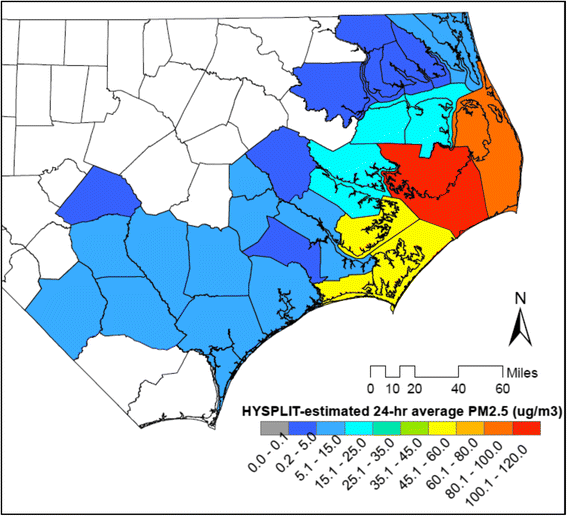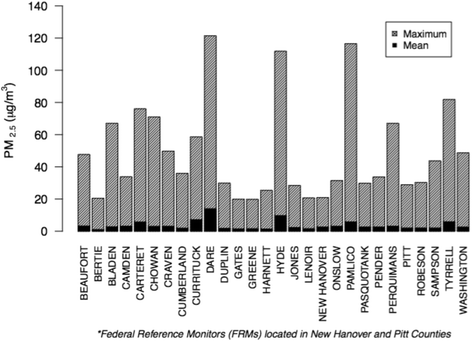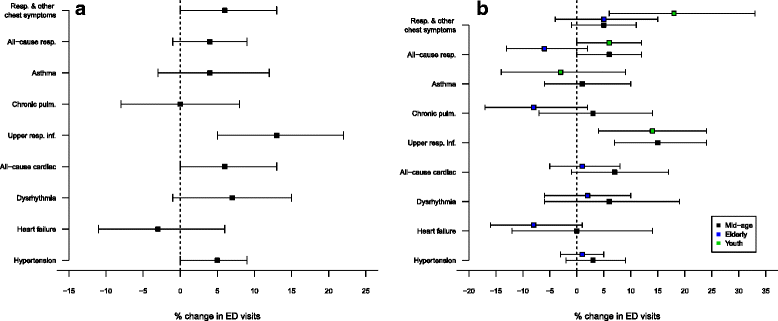Repeating cardiopulmonary health effects in rural North Carolina population during a second large peat wildfire
- PMID: 26818940
- PMCID: PMC4728755
- DOI: 10.1186/s12940-016-0093-4
Repeating cardiopulmonary health effects in rural North Carolina population during a second large peat wildfire
Abstract
Background: Cardiovascular health effects of fine particulate matter (PM2.5) exposure from wildfire smoke are neither definitive nor consistent with PM2.5 from other air pollution sources. Non-comparability among wildfire health studies limits research conclusions.
Methods: We examined cardiovascular and respiratory health outcomes related to peat wildfire smoke exposure in a population where strong associations were previously reported for the 2008 Evans Road peat wildfire. We conducted a population-based epidemiologic investigation of associations between daily county-level modeled wildfire PM2.5 and cardiopulmonary emergency department (ED) visits during the 2011 Pains Bay wildfire in eastern North Carolina. We estimated changes in the relative risk cumulative over 0-2 lagged days of wildfire PM2.5 exposure using a quasi-Poisson regression model adjusted for weather, weekends, and poverty.
Results: Relative risk associated with a 10 μg/m(3) increase in 24-h PM2.5 was significantly elevated in adults for respiratory/other chest symptoms 1.06 (1.00-1.13), upper respiratory infections 1.13 (1.05-1.22), hypertension 1.05 (1.00-1.09) and 'all-cause' cardiac outcomes 1.06 (1.00-1.13) and in youth for respiratory/other chest symptoms 1.18 (1.06-1.33), upper respiratory infections 1.14 (1.04-1.24) and 'all-cause' respiratory conditions 1.09 (1.01-1.17).
Conclusions: Our results replicate evidence for increased risk of cardiovascular outcomes from wildfire PM2.5 and suggest that cardiovascular health should be considered when evaluating the public health burden of wildfire smoke.
Figures



Similar articles
-
Effects of long-term exposure to traffic-related air pollution on respiratory and cardiovascular mortality in the Netherlands: the NLCS-AIR study.Res Rep Health Eff Inst. 2009 Mar;(139):5-71; discussion 73-89. Res Rep Health Eff Inst. 2009. PMID: 19554969
-
The association of wildfire smoke with respiratory and cardiovascular emergency department visits in Colorado in 2012: a case crossover study.Environ Health. 2016 Jun 4;15(1):64. doi: 10.1186/s12940-016-0146-8. Environ Health. 2016. PMID: 27259511 Free PMC article.
-
The San Diego 2007 wildfires and Medi-Cal emergency department presentations, inpatient hospitalizations, and outpatient visits: An observational study of smoke exposure periods and a bidirectional case-crossover analysis.PLoS Med. 2018 Jul 10;15(7):e1002601. doi: 10.1371/journal.pmed.1002601. eCollection 2018 Jul. PLoS Med. 2018. PMID: 29990362 Free PMC article.
-
Critical Review of Health Impacts of Wildfire Smoke Exposure.Environ Health Perspect. 2016 Sep;124(9):1334-43. doi: 10.1289/ehp.1409277. Epub 2016 Apr 15. Environ Health Perspect. 2016. PMID: 27082891 Free PMC article. Review.
-
The effect of wildfire smoke on children's health: A systematic review.Paediatr Perinat Epidemiol. 2025 Jan;39(1):110-119. doi: 10.1111/ppe.13141. Paediatr Perinat Epidemiol. 2025. PMID: 39887446
Cited by
-
Conservation of carbon resources and values on public lands: A case study from the National Wildlife Refuge System.PLoS One. 2022 Jan 12;17(1):e0262218. doi: 10.1371/journal.pone.0262218. eCollection 2022. PLoS One. 2022. PMID: 35020751 Free PMC article.
-
Wildfire-relevant woodsmoke and extracellular vesicles (EVs): Alterations in EV proteomic signatures involved in extracellular matrix degradation and tissue injury in airway organotypic models.Environ Res. 2025 Jan 1;264(Pt 2):120395. doi: 10.1016/j.envres.2024.120395. Epub 2024 Nov 19. Environ Res. 2025. PMID: 39571711
-
Wildland fire smoke and human health.Sci Total Environ. 2018 May 15;624:586-595. doi: 10.1016/j.scitotenv.2017.12.086. Epub 2017 Dec 27. Sci Total Environ. 2018. PMID: 29272827 Free PMC article. Review.
-
Wood smoke particle exposure in mice reduces the severity of influenza infection.Toxicol Appl Pharmacol. 2021 Sep 1;426:115645. doi: 10.1016/j.taap.2021.115645. Epub 2021 Jul 13. Toxicol Appl Pharmacol. 2021. PMID: 34271066 Free PMC article.
-
Smoldering and flaming biomass wood smoke inhibit respiratory responses in mice.Inhal Toxicol. 2019 May;31(6):236-247. doi: 10.1080/08958378.2019.1654046. Epub 2019 Aug 20. Inhal Toxicol. 2019. PMID: 31431109 Free PMC article.
References
-
- Lim SS, Vos T, Flaxman AD, Danaei G, Shibuya K, Adair-Rohani H, et al. A comparative risk assessment of burden of disease and injury attributable to 67 risk factors and risk factor clusters in 21 regions, 1990–2010: a systematic analysis for the global burden of disease study. Lancet. 2010;380(9859):2224–2260. doi: 10.1016/S0140-6736(12)61766-8. - DOI - PMC - PubMed
-
- U.S. Environmental Protection Agency (EPA) Integrated science assessment for particulate matter. Research Triangle Park: Environmental Protection Agency, National Center for Environmental Assessment, Office of Research and Development; 2009. p. 2228.
Publication types
MeSH terms
Substances
Grants and funding
LinkOut - more resources
Full Text Sources
Other Literature Sources

